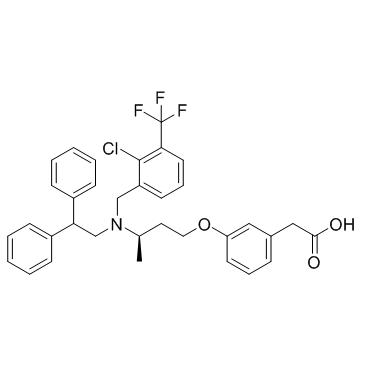RGX-104 free Acid
Modify Date: 2024-01-05 19:25:16

RGX-104 free Acid structure
|
Common Name | RGX-104 free Acid | ||
|---|---|---|---|---|
| CAS Number | 610318-54-2 | Molecular Weight | 596.08 | |
| Density | N/A | Boiling Point | N/A | |
| Molecular Formula | C34H33ClF3NO3 | Melting Point | N/A | |
| MSDS | N/A | Flash Point | N/A | |
Use of RGX-104 free AcidRGX-104 (free base) is an orally bioavailable and potent liver-X nuclear hormone receptor (LXR) agonist that modulates innate immunity via transcriptional activation of the ApoE gene. |
| Name | RGX-104 free Acid |
|---|
| Description | RGX-104 (free base) is an orally bioavailable and potent liver-X nuclear hormone receptor (LXR) agonist that modulates innate immunity via transcriptional activation of the ApoE gene. |
|---|---|
| Related Catalog | |
| Target |
LXR[1] |
| In Vivo | Oral administration of RGX-104 to animals bearing palpable tumors significantly suppresses the growth of multiple cancer types. Strong tumor growth suppression is also observed in animals bearing large tumors. In some instances, RGX-104 treatment causes partial or complete tumor regression. What’s more, it is also found that co-administration of RGX-104 with anti-PD-1 is superior to administration of either RGX-104 or anti-PD-1 alone. Importantly, co-administration of RGX-104 with anti-PD-1 therapy is well tolerated by mice, with no overt signs of toxicity[1]. |
| Cell Assay | Bone marrow cells are cultured with B16F10 melanoma cells and GM-CSF for 6 days. On day 3, RGX-104 (2 μM) is added to the culture. The mean number of Gr-1high CD11b+ cells per 50 mL of culture solution is assessed by flow cytometry on day 6[1]. |
| Animal Admin | Mice[1] B16F10 cancer cells are subcutaneously injected into C57BL/6 mice. Following tumor growth to 5-10 mm3 in volume, mice are fed either control chow, chow supplemented with GW3965 (100 mg/kg), or chow supplemented with RGX-104 (100 mg/kg)[1]. |
| References |
| Molecular Formula | C34H33ClF3NO3 |
|---|---|
| Molecular Weight | 596.08 |
| Storage condition | 2-8℃ |